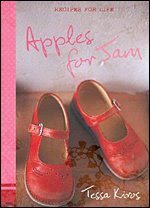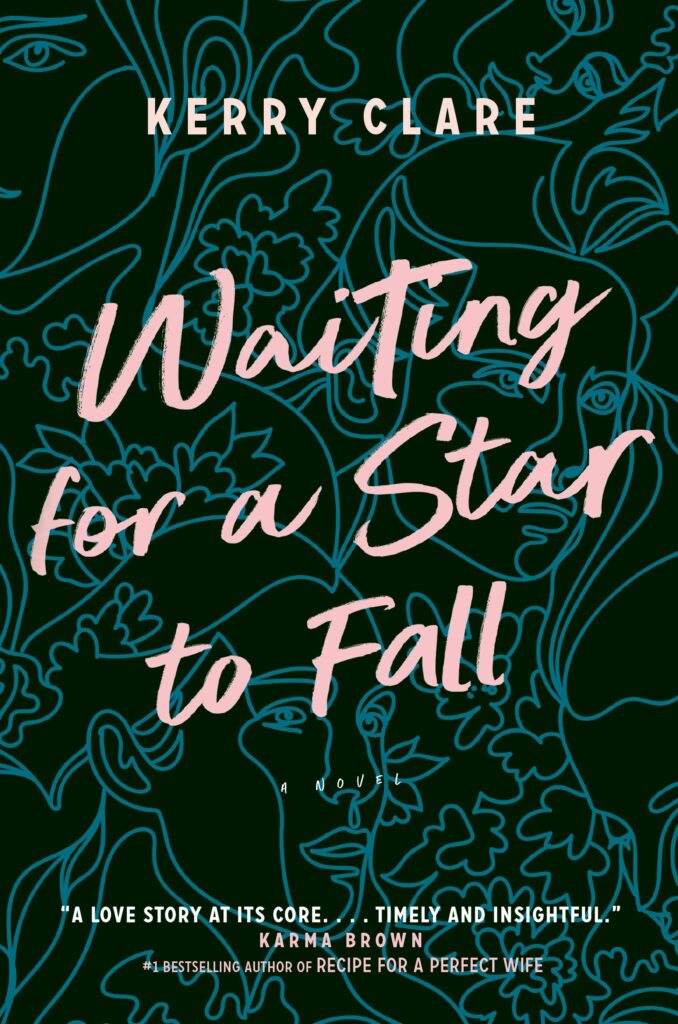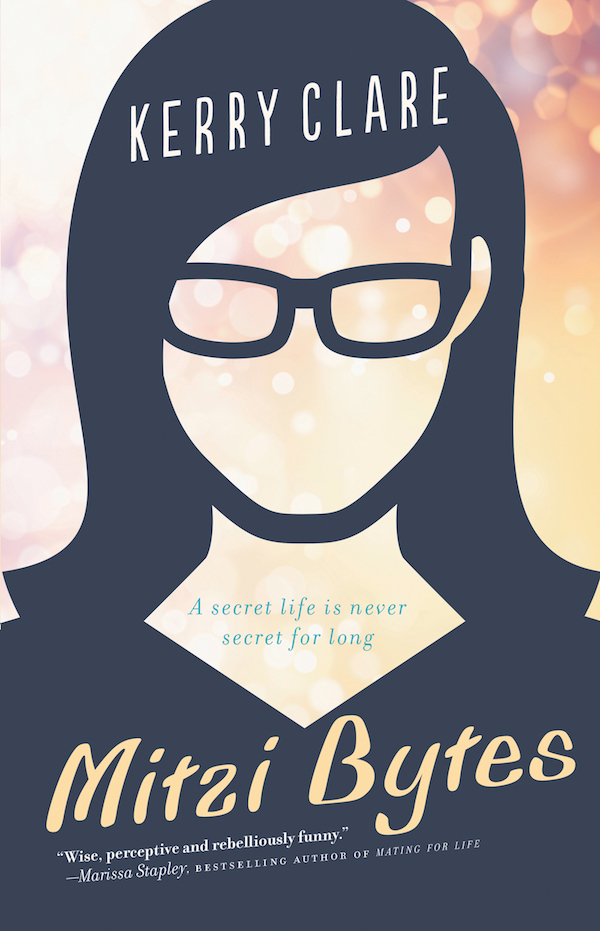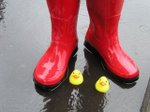March 19, 2009
In addition
I’m now reading The Believers by Zoe Heller, who I’ve loved a long long time. On the weekend I read Anne Fleming’s Pool-Hopping, which, in addition to being swim-lit, was a stellar collection of stories. In light of her latest book Life Sentences, the remarkable Laura Lippman’s top ten memorable memoirs. Today I was sent a link to Based On Books, an interesting review site of books-based films. The Flying Troutmans is named to The Orange Prize longlist. Charlotte Ashley’s Tangential to a History of Reading points to significant flaws in Sydney Henderson’s literary character. And on literature and returning soldiers.
March 19, 2009
Get Excited
 Via BoingBoing, which came to my attention via Stu. Though we could all use a stiff upper lip, of course, this strikes me as much more fun.
Via BoingBoing, which came to my attention via Stu. Though we could all use a stiff upper lip, of course, this strikes me as much more fun.
March 18, 2009
Dispatches
Via Crooked House, I came across a post about pregnancy at Moonlight Ambulette with an excerpt from the short story “Another Marvelous Thing” by the wondrous Laurie Colwin. “For the past two months her chief entertainment had been to lie in bed and observe her unborn child moving under her skin. It had knocked a paperback book off her stomach and caused the saucer of her coffee cup to jiggle and dance.”
My unborn child is not yet so mighty, but staring at my fascinating stomach has already become a kind of pastime, and I don’t think I’ve really come across any other literature yet that so encapsulates the experience of being pregnant. Or at least in a way that doesn’t border on the nightmare, and I’m aware that pregnancy can indeed border on nightmare, but so many of these books and stories exploit pregnancy for its literary effect rather than capturing the moment for itself. I’m thinking even of very good novels– Novel About My Wife by Emily Perkins, for instance, The Fifth Child by Doris Lessing, or The Edible Woman does a bit of it. Of course there are also numerous books in which woman dies in childbirth or botched abortion (which I seem to keep picking up unknowingly), or where she miscarries at three or four months (or whatever month I happened to be at when I was reading said story or book [writers beware: a miscarriage is not a plot device.])
Oh, but Laurie Colwin. I should go back and read A Big Storm Knocked it Over and Happy All the Time, both of which depict pregnancy, I remember. The baby kicks punctuating The Fat Woman Next Door is Pregnant managed something of it too. Perhaps Barbara Kingsolver’s Prodigal Summer, but there pregnancy was more a metaphor than anything else.
Anne Enright has called motherhood “the place before stories start”, describing her surprise at finding it was not the sort of journey that one could send dispatches home from. Is this the problem then, I wonder? Who else has managed to send home some dispatches all the same?
March 18, 2009
The post in literature
Though I make no bones about literature in the post being my very favourite thing, a close second has to be the post in literature. Two such highlights lately (and by UofT creative writing grads) being Laura Boudreau’s story “Strange Pilgrims” in The New Quarterly 109 (out now), and Naya’s brilliant post “Stamping and Stomping”. Clearly, clearly, after my heart.
March 16, 2009
Long Weekend Chocolate Banana Cake
 Very experimental, and driven by my ceaseless craving for banana-full baked goods. Eggless “wacky” cake on the bottom, and banana bread recipe from my breadmaker (except cooked in the oven) on top. Iced, rather unfortunately, with store-bought Betty Crocker as all my icing recipes have a raw egg beaten in and I’m not permitted such indulgences in my condition. Product is perfect though, and absolutely delicious. Promptly sliced into four, and distributed amongst my neighbours in order to prevent hastening of my immediate-onset obesity. With plenty still left for us to finish tonight during Midsomer Murders, accompanied by big glasses of (organic) milk.
Very experimental, and driven by my ceaseless craving for banana-full baked goods. Eggless “wacky” cake on the bottom, and banana bread recipe from my breadmaker (except cooked in the oven) on top. Iced, rather unfortunately, with store-bought Betty Crocker as all my icing recipes have a raw egg beaten in and I’m not permitted such indulgences in my condition. Product is perfect though, and absolutely delicious. Promptly sliced into four, and distributed amongst my neighbours in order to prevent hastening of my immediate-onset obesity. With plenty still left for us to finish tonight during Midsomer Murders, accompanied by big glasses of (organic) milk.
March 16, 2009
Life Sentences by Laura Lippman
 Laura Lippman is a remarkable writer, and I come bearing proof: she is a female writer of popular fiction who garners New York Times reviews. She is an established crime writer successfully expanding her literary horizons (when lately we’ve often seen it the other way around). In her latest novel Life Sentences, her main character is a fifty year-old silver-haired woman with a (beside the point) voracious and oft-satisfied sexual appetite, and how often do we encounter such women in popular culture at all?
Laura Lippman is a remarkable writer, and I come bearing proof: she is a female writer of popular fiction who garners New York Times reviews. She is an established crime writer successfully expanding her literary horizons (when lately we’ve often seen it the other way around). In her latest novel Life Sentences, her main character is a fifty year-old silver-haired woman with a (beside the point) voracious and oft-satisfied sexual appetite, and how often do we encounter such women in popular culture at all?
I first encountered Lippman with her 2007 novel What the Dead Know, a stand-alone book (Lippman is known for her Tess Monaghan PI novels) that was critically acclaimed and won the 2007 Quill Award, and I read her short story collection Hardly Knew Her not long ago. I’ve been impressed by her ability to cultivate suspense, to challenge her readers with unsympathetic characters, to effectively use language and literary references, and by her blunt and unflinching prose.
I wasn’t as immediately drawn into Life Sentences, however, perhaps due to the fragmented nature of the narrative. Eventually, however, this method made sense. The centre of this story is Cassandra Fallows, best-selling author of two memoirs, and poorly-selling author of a new attempt at fiction. The story begins with her catching a news story on television about a woman who refuses to disclose the whereabouts of her missing child. The reporter referencing a similar story from twenty years before, about a woman called Calliope Jenkins in Baltimore. Cassandra, a Baltimore native, realizing that Calliope Jenkins had been one of her school mates, and deciding that within this coincidence, the buds of a new book might lurk.
Lippman constructs her own story with Cassandra’s pursuit of this bud (in third-person), excerpts from her memoir Her Father’s Daughter (about growing up in the shadow of her formidable academic father, who abandoned their family for a woman he met in the race riots following the 1968 murder of Martin Luther King), and third person accounts by others involved in the Calliope Jenkins case– her lawyer, the detective, old school friends of both Cassandra and Callope–none of whom have any interest in talking to Cassandra at all.
There are two reasons for their reticence, and for the school friends in particular, it’s because they don’t trust Cassandra. They’d been portrayed in her previous memoirs, in ways they claim are grossly inaccurate, and resent Cassandra’s tendency to make herself the centre of every story she tells. They don’t remember their unit being as tight as Cassandra does, picturing her more on the periphery of their experience. Particularly galling, they find, is how Cassandra had taken the story of King’s death and ensuing riots, making these events the backdrop for her tenth birthday party.
But some of these friends also have something to hide, as do the officials involved in the Calliope Jenkins case, who have never recovered from the experience of dealing with this woman who refused to talk. From the knowledge also that somewhere out there is a dead child, and that nobody was ever able to find him. Like much of Lippman’s crime fiction (and interestingly enough in relation to Cassandra’s own relationship with fact and fiction), Calliope Jenkins’ story is based on an actual case. Lippman has Callie living now an anonymous life in Delaware, having been freed after seven years in prison. Cassandra Fallows is determined to find her, and though sources try to thwart her at every turn, such thwartings are telling of the characters committing them, and Cassandra only presses on.
Lippman accomplishes not such a sleight of hand in crafting this story, the revelation being less-than startling, but the story’s own substance in the point instead. Metafictional dealings with fact and fiction, the nature of memoir and memory, a main character whose reliability is undermined from the very start (and complicated by the fact that she’s oblivious to this). Cassandra Fallows who talks too much, and Calliope Jenkins who doesn’t talk at all, and yet somehow between them the story must be told, which Lippman manages deftly.
March 16, 2009
What I've learned about children's books
 Behold, The Baby’s library, which is a work in progress but well underway. The “nursery” is beginning to come together, which is wonderful, but I continue to be more concerned with the library than any other aspect of it. Perhaps because it means I get to focus on BOOKS rather than the solid terrifying fact of a baby coming to live at our house in just ten weeks. (Eeek. That’s ages away, right?)
Behold, The Baby’s library, which is a work in progress but well underway. The “nursery” is beginning to come together, which is wonderful, but I continue to be more concerned with the library than any other aspect of it. Perhaps because it means I get to focus on BOOKS rather than the solid terrifying fact of a baby coming to live at our house in just ten weeks. (Eeek. That’s ages away, right?)
In less frightening news in children’s literature, I am finding my experience at The Children’s Book Bank quite fascinating. I remember last December at the Art Matters “A Passion for Reading” panel that my co-panelist, author/illustrator Genevieve Cote provoked a bit of controversy by suggesting that in her experience (through school visits), boys and girls liked different kinds of books. Which is not the sort of thing some people like to hear, but I find it to be true with adult boys and girls, so why not with the wee ones?
I wish it weren’t particularly so, but the little boys I read with at the Book Bank are riveted by books about trucks, and the girls love ones about princesses and fairies. Neither book in either genre even has to be good or interesting, but these kids know what they like. When the girls get older, the fairy fixation continues with a rather wretched series called The Rainbow Magic Fairies, which probably isn’t any worse than The Babysitters Club and Sleepover Friends, which I was devoted to at that age. They all like novelized versions of TV shows and movies. Jillian Jiggs and Robert Munsch go over as well as they did when I was little. (Yesterday a little boy informed me that he knew Robert Munsch. “Really?” I asked. “How do you know him?” “Well, I have his books,” he said.)
Kids have become accustomed to really amazing and dynamic illustrations in books, which means that classic stories like Make Way for Ducklings or Blueberries for Sal often get picked over. Of Eric Carle, no one can get enough. Dora The Explorer books are more educational tools than books, but they’re less obnoxious than I thought they’d be. Surprisingly, Barbie books aren’t atrocious, but they’re all a little bit dumb. Madeleine still has her fans, and Curious George is timeless.
March 16, 2009
Catalogues
 Like most people who’ve spent time working in libraries, I’ve got a thing about cataloguing. And it’s alpha-order for me as a rule, which you’d know if you’ve ever seen my own library, or my CD collection. I get a bit horrified when I hear about libraries ordered by size or colour, for example, which might be gorgeous to see, but how do you ever find anything? It also makes the books less books than decor, which is gross. The colour chaos of my own alphabetized spines are pretty mesmerizing anyway.
Like most people who’ve spent time working in libraries, I’ve got a thing about cataloguing. And it’s alpha-order for me as a rule, which you’d know if you’ve ever seen my own library, or my CD collection. I get a bit horrified when I hear about libraries ordered by size or colour, for example, which might be gorgeous to see, but how do you ever find anything? It also makes the books less books than decor, which is gross. The colour chaos of my own alphabetized spines are pretty mesmerizing anyway.
But today I had two overlapping experiences of cataloguing/classification that were quite remarkable. First, we went back to Good Egg in Kensington Market (because the weather was sunny and warm, and evidently most of the city thought the Market was a good destination.) My husband has grown very tired of having to venture in there over and over again to visit “my book”, Apples for Jam by Tessa Kiros. (It was actually her other book Falling Cloudberries that I originally coveted, but I decided Apples for Jam would be more practical, and it was almost just as beautiful.) I wasn’t about to just buy it, as it’s quite expensive, but having had enough of lingering in bookstores (he enjoys it less than I do, and it was the second one today), Stuart yanked the copy out of loving arms, and proceeded to the till. So now I own the book of dreams (this week), and can die now.
I’ve written about Good Egg before, how it’s a treasure trove. The books obviously selected with care, but the method of selection not always immediately obvious. That the children’s section contains Alligator Pie, The Carrot Seed, No I Will Not Ever Never Eat a Tomato, and sushi yuppie baby board books. In the window, Omnivore’s Dilemma (obvious) was on display beside Wetlands (for the avocado photo on the cover, I presume). Just the widest interpretation of “food books” imaginable, and I love it.
I love also Apples for Jam, just as much as I thought I would. And how brilliant that the whole book is organized, not by ingredients, or courses, or kinds of dishes, but by colour. Each chapter a colour, except the last two which are “multi-coloured” and”stripes”. So that strawberry sorbet is featured alongside tomato lasagne, beetroot gnocchi with baked ham and cheese bread pudding, white risotto in spinach broth and lemon rice pudding with roasted peaches. The whole book is a rainbow, and the order makes sense. I look forward to trying these recipes, and then the eating. Yum.
March 12, 2009
A Brief History of Anxiety (Yours and Mine) by Patricia Pearson
 Though I’ve never considered myself laid back (or at least not since I faced a chorus of laughter this one time when I suggested that I was), I’ve never known anything like the anxiety I’ve faced during the last six months since finding out I was pregnant. Numerous times I’ve remarked how fortunate it is that I’ve had no real problems during my pregnancy, seeing as I’ve managed to drive myself absolutely crazy with the imaginary ones. Concocted, I think, because for some reason I’m unable to believe that things are going well without physical evidence of that fact, or any real control over its occurrence. That I’ve never been so powerless has sent me into a semi-permanent state of panic, and so I decided to read Patricia Pearson’s book A Brief History of Anxiety (Yours and Mine)— now out in paperback– in order to make some sense of what I’ve been feeling.
Though I’ve never considered myself laid back (or at least not since I faced a chorus of laughter this one time when I suggested that I was), I’ve never known anything like the anxiety I’ve faced during the last six months since finding out I was pregnant. Numerous times I’ve remarked how fortunate it is that I’ve had no real problems during my pregnancy, seeing as I’ve managed to drive myself absolutely crazy with the imaginary ones. Concocted, I think, because for some reason I’m unable to believe that things are going well without physical evidence of that fact, or any real control over its occurrence. That I’ve never been so powerless has sent me into a semi-permanent state of panic, and so I decided to read Patricia Pearson’s book A Brief History of Anxiety (Yours and Mine)— now out in paperback– in order to make some sense of what I’ve been feeling.
It is sort of ironic, however, that I turn to a book in order to understand anxiety, a book whose thesis is that anxiety is so prominent in our society because rational thought sells us short. Because we’re the kind of people who think our thoughts and emotions can be summed up and explained in a book, just say. But still, Pearson manages this. Her book’s effectiveness partly due to its unique approach– part memoir, part history, all readable and fascinating.
Pearson contextualizes her own experiences with anxiety through a close cultural and historical analysis of the phenomenon. And phenomenon does tend to be the right word– incidences of anxiety are unprecedentedly high in the Western world at this point of time, and Pearson seeks to make sense of this. Suggesting the culprit might be that “implausible myth: that we can assume mastery over our fates.” Which began out of the middle ages with the development of “reason as a new mechanism for keeping anxiety at bay… Reason– or rationalism, more specifically– evolved out of a need to impose order on a world that was both fraught with danger and haunted with ghosts.”
But the ghosts creep in, or rather, the holes in rationalism are all too apparent. Life in its randomness can be absolutely terrifying, particularly for those of us privileged to have become far more accustomed to order and control.
Pearson’s personal experiences colour this history– she writes of her first breakdown, of childhood incidence of fear and anxiety (which occurs, Pearson explains, because of the amygdala (“which act as the sensory headquarters of mammalian fear, [sending] out five-alarm panic signals” to the cerebral cortex, which in a child is “a work in progress, [so] she cannot yet rationally assess the threat…”). She writes of our acknowledgment of anxiety disorders, which weren’t diagnosed years ago, though there have always been people suffering from “nerves” (so-called to in order to make mental problems physical, and eliminate the stigma). Pearson uses her experience as a crime reporter to illuminate our relationship to fear, as well as our attraction to certain versions of it. She also deals with her reliance on anti-depressants, which became an addiction, asserting that these medications are over-prescribed by doctors who are sold by big drugs companies, and have no real understanding of what these medications do.
A Brief History of Anxiety made me feel better. Though hardly a self-help guide, or a typical memoir at all, it was such a pleasure to read, such a relief to see my own experience reflected, and to understand that it takes place in a context outside of myself. What a pleasure also to learn so much in general, a fascinating education. Plus, it’s funny– Pearson is an excellent writer.
March 11, 2009
A cynical deception
“It sometimes seemed to Molly that the library was a place of silent discord and anarchy, its superficial tranquility concealing a babel of assertion and dispute. Fiction is one strident lie– or rather, many competing lies; history is a long narrative of argument and reassessment; travel shouts of self-promotion; biography is just pushing a product. As for autobiography… And all this is just fine. That is the function of books: they offer a point of view, they offer many conflicting points of view, they provoke thought, they provoke irritation and admiration and speculation. They take you out of yourself and put you down somewhere else from whence you never entirely return. If the library were to speak, Molly felt, if it were to speak with a thousand tongues, there would be a deep collective growl coming from the core collection up on the high shelves, where the voices of the nineteenth century would be setting precedents, the bleats and cries of a new opinion, new fashion, new style. The surface repose of a library is a cynical deception.” –Penelope Lively, Consequences





